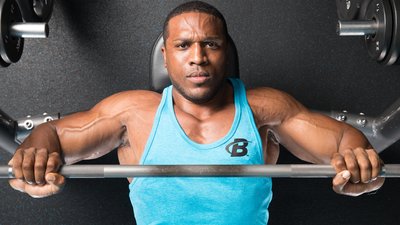Go to your favorite box gym on any Monday, and you'll see a trend that isn't going anywhere: people lining up for the barbell flat bench like it's a cattle call. It's just one of those things. No matter how much strength coaches shout about the importance of other movements like squats, overhead presses, and deadlift variations, the bench press will probably remain the most glamourized movement in the gym.
Is this a bad thing? A good thing? Let's just say…it's a thing. That means its value, as ever, depends on what you do with it, and how you manage to (hopefully) avoid jacking yourself up with it.
Truth 1: It's not the best chest developer
It's unavoidable: people hear "bench press," and they think "chest." In truth, the flat barbell bench press is only partially effective in taxing the chest fibers. And since the movement is guided by a barbell with a fixed hand and elbow position, it demands plenty of contribution from other muscles, like the front delts and triceps. Even if you put your feet up on the bench and do all the other classic bro stuff, this is never going to be an effective isolation move.
Don't get me wrong—you'll still get your pump fix if you train in the right rep ranges and use the right loads to stimulate. But a heavy bench press is more of an upper-body strength move, and less of a chest sculptor. Come to terms with it.
What this means for you: If you want a big chest, do plenty of chest-focused movements like flyes and squeeze presses, but also high-rep push-up finishers. When you bench heavy, treat it as a strength move and follow the standards I lay out in my article "Stop Maxing Out! Lift This Way Instead." Aim for heavy triples rather than singles, control your pace, and incorporate strategic pauses.
Truth 2: It's not for everyone
There are plenty of people who can go balls-to-the-wall with any movement while remaining injury free. Others can't even look at weights without rubbing the front of their shoulder. Even good technique will only get the second group so far. They may simply be contraindicated for benching, due to the nature of that lift and their body.
Put even more bluntly, the bench press doesn't promote healthy shoulders. The reason why comes down to the shoulder blades. Pinning your scapula back on a bench while allowing the upper arm to go through a large range of motion—especially when loaded heavily—frustrates a natural "rhythm" that should exist between the humerus and scapula.
Here's what I mean by rhythm: For every few degrees the arm moves, the shoulder blade should congruently move a degree as well. Patients who suffer from frozen shoulder syndrome, for example, have major dysfunction in this rhythm. This is what makes movements like the overhead press more functionally applicable as a training tool. There's nothing to restrict the shoulder blade from moving up and down on the ribcage.
What this means for you: If you find that you can't bench without shoulder pain, don't feel like you have to. And even if you can bench without pain, do yourself a favor and work on your posture, scapular strength, and lower traps with the tips I lay out in my article "3 Tips to Beat That Hunchback."
Truth 3: It's not the most complete test of upper-body strength
Plenty of lifters want to have a strong bench in order to impress someone. But no matter who you're looking to "wow," there's plenty wrong with using the bench as a test lift.
For example, you may be able to lift more weight on the bench than, say, a strict overhead press, but there are also plenty more ways to "cheat" on the bench. Using a bizarrely high arch or stopping short of a full range of motion are two common flaws. Lifting the hips off the bench for assistance is another. Being honest with your technique is a humbling experience, and there's hardly any room for this when standing upright.
Moreover, the bench press targets less of the upper-body musculature than the overhead press. There's no doubt it hits the chest, and also the triceps and front deltoids. But, there's very little stress placed on the spine at all, meaning the muscles of the trunk, like the abdominals and obliques, don't have to become too involved for a successful lift to be completed.
What this means for you: "How much ya bench" tells me far less about you as a lifter than "how much ya strict press?" You might see more bang for your training buck by focusing on overhead work as a gauge of strength, and using horizontal press variations like close-grip bench work as a triceps-focused accessory move. When you can strict press more than 200 pounds for a smooth triple, like I advocate in my article "How to Lift 200 Pounds Overhead," revisit your bench and don't be surprised if it's actually grown.
Truth 4: Not all cues work for all benchers
We all know that lifters trade technique cues like baseball cards. But, something that works for a seriously strong-ass bencher may not work for someone who's not at that level yet. An example is the classic "pull the bar apart" cue.
I recommend squeezing in on the bar—provided it doesn't mean your scapula get unlocked. Scandalous, right? No, that won't be the best cue for everyone either. For some people, pulling apart is definitely the right cue. But not everyone.
What it means for you: Don't just blindly follow a cue and expect it to work! Shop around, and don't be afraid to try something completely different than what someone way, way stronger than you advocates—once you've got your basic form locked down tight, that is.
Truth 5: Benching right demands a complicated, precise set-up
I hope you don't interpret this article as me telling you not to bench. Really, I'm just trying to tell you that when you bench, you really need to focus on doing it right with every rep of every set. Compared to a move like the deadlift, benching can seem pretty straightforward, but in actuality, it's every bit as complicated, and demands just as much attention to set-up.
Here's the checklist you need to do for every rep. Don't skip a single step!
- Back position: Your head, upper back, and butt should be in contact with the bench. A flat lower back is counterproductive in the case of this lift, and keeps you from being able to lock your shoulders in a safe position. Keep space under that lumbar!
- Hand position: Personally, I like a slightly narrower grip than most people bench with. As I say in the video, I'll aim for the pinky fingers on the rings of the barbell. You may go slightly wider or narrower based on your proportions, but avoid flaring the elbows out too far away from your body—even when your goal is a heavy low-rep set. Use a grip width that allows the forearm to stay vertical and perpendicular to the floor, keeping the elbows right under the wrists. Yes, you'll be able to bench less in this narrow width than if you went super wide with the elbows flared. No, I don't care.
- Foot position: Pull your feet in to about a 90-degree angle at the knee, or slightly tighter. This will allow you to press your feet into the ground solidly to help drive the bar away from you.
- Bar path: You don't want a straight line—that's too rough on the elbows and shoulders. Pushing backward, or slightly toward the rack, is a far more natural motion for your shoulders. If you're someone with longer arms, you may need a contact point on the torso that's a bit lower than normal to achieve the right arm angle relative to the body.
- Shoulder blades: Remember to keep the shoulders back through the entire lift! That means during the lockout in rep 1, and still there in reps 8, 10, 12, and onward. This will shorten the amount you can lock out, but will ultimately protect your shoulders from injury.
You've heard my piece. Now go bench—and do it right!



